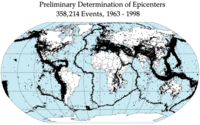
Photo from wikipedia
The 2008 Mw 7.9 Wenchuan, China, earthquake produced many damaging landslides in the Longmenshan region along the eastern margin of the Tibetan Plateau, China. Among the thousands of reported landslides,… Click to show full abstract
The 2008 Mw 7.9 Wenchuan, China, earthquake produced many damaging landslides in the Longmenshan region along the eastern margin of the Tibetan Plateau, China. Among the thousands of reported landslides, some are geologically notable because of their close spatial relationship to local fault rupture complexities. The Leigu landslide is particularly interesting because it formed at a restraining bend along the Beichuan-Yingxiu fault system in a structural position that favored hill-slope collapse because of a variety of preexisting structural and geomorphological conditions. The 2008 landslide reactivated an older landslide that is indicated by a preserved paleo-scarp upslope from the main 2008 event scarp. Our field and analytical results coupled with a review of existing geological information on the region indicate that the landslide site is located between two regional folds with opposing plunge directions and that the restraining bend is the displacement transfer zone between two parallel, but offset segments of the Beichuan-Yingxui Fault system. In addition, NE-oriented steep joints were reactivated as slip surfaces in the upper slopes of the landslide area within an anticline hinge zone that focuses vertical uplift. Steep valley walls due to incision of the antecedent Laochangkou River and abundant rainfall during the earthquake period, combined with intense seismic acceleration were contributing factors to the landslide event. During the earthquake, approximately equal components of strike-slip and SE-directed thrusting occurred on surface ruptures within the bend, offsetting older landslide deposits and man-made structures. Field results indicate that sliding was facilitated by loose unconsolidated materials from the previous landslide that were remobilized above a soft, low-friction basal slip surface. The Leigu landslide provides an important case study for evaluating potential landslide hazards close to active fault systems where complex 3-D structural geometries and high-relief, steep terrain combine to generate significant ground instability during large magnitude earthquakes.
Journal Title: Landslides
Year Published: 2019
Link to full text (if available)
Share on Social Media: Sign Up to like & get
recommendations!